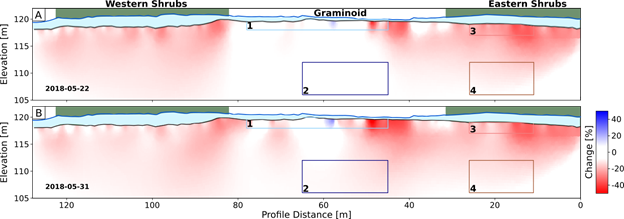February 01, 2021
Investigating Dynamics that Reshape Permafrost Environments
Geophysical monitoring shows that spatial heterogeneity in thermohydrological dynamics reshapes transitional permafrost environments

Snowmelt is causing rapid change in electrical resistivity, particularly underneath tall shrubs where thick snowpack is insulating the ground, enabling rapid and significant infiltration of snowmelt, which increases vertical and then lateral water and heat flow.
[Reprinted under Creative Commons Attribution-NonCommercial 4.0 International (CC BY-NC 4.0) from Uhlemann, S., et al. “Geophysical Monitoring Shows that Spatial Heterogeneity in Thermohydrological Dynamics Reshapes a Transitional Permafrost System.” Geophysical Research Letters 48 (6), e2020GL091149 (2021). DOI:10.1029/2020GL091149]
The Science
When permafrost thaws, water can flow quicker through the ground, creating a complex subsurface flow system. Researchers from Lawrence Berkeley National Laboratory gained insight into these processes by measuring the electrical resistivity of the ground daily. Results show that vegetation and the snowpack that accumulates on the vegetation in winter control the temperatures of the ground and the flow of water in the ground. Where snow accumulates, temperatures stay warmer and water and energy from snowmelt and rain can flow through the ground quickly. Where the snowpack is thin, ground temperatures are colder, preventing flow.
The Impact
By highlighting the link between above- and belowground properties and processes in the Arctic, these results will be useful for improving predictions of Arctic feedback to climate change. They also show that Arctic systems are changing rapidly. The data highlight that permafrost at the research team’s study site could disappear within the next decade. This process could be accelerated by changes in snowpack distribution and rainfall patterns.
Summary
Climate change is causing rapid changes of Arctic ecosystems. Yet the data needed to unravel complex subsurface processes are very rare. Using geophysical and in situ sensing, researchers closed an observational gap associated with thermohydrological dynamics in discontinuous permafrost systems. Monitoring for more than 2 years, their data highlight the impact of vegetation, topography, and snow thickness distribution on subsurface thermohydrological properties and processes. Large snow accumulation near tall shrubs insulates the ground and allows for rapid and downward heat flow. Thinner snowpack above the graminoid results in surficial freezing and prevents water from infiltrating into the subsurface. Analyzing short-term disturbances such as snowmelt or heavy rainfall, the team found that lateral flow could be a driving factor in talik formation. Interannual measurements show that deep permafrost temperatures increased by about 0.2°C over 2 years. The results, which suggest that snow-vegetation-subsurface processes are tightly coupled, will be useful for improving predictions of Arctic feedback to climate change, including how subsurface thermohydrology influences carbon dioxide and methane fluxes.
Principal Investigator
Sebastian Uhlemann
Lawrence Berkeley National Laboratory
suhlemann@lbl.gov
Program Manager
Daniel Stover
U.S. Department of Energy, Biological and Environmental Research (SC-33)
Environmental System Science
daniel.stover@science.doe.gov
Funding
This research was supported by the Office of Biological and Environmental Research (BER) in the U.S. Department of Energy’s (DOE) Office of Science (Grant No. DE-AC02-05CH11231).
References
Uhlemann, S., et al. "Geophysical Monitoring Shows that Spatial Heterogeneity in Thermohydrological Dynamics Reshapes a Transitional Permafrost System." Geophysical Research Letters 48 (6), e2020GL091149 (2021). https://doi.org/DOI:10.1029/2020GL091149.

